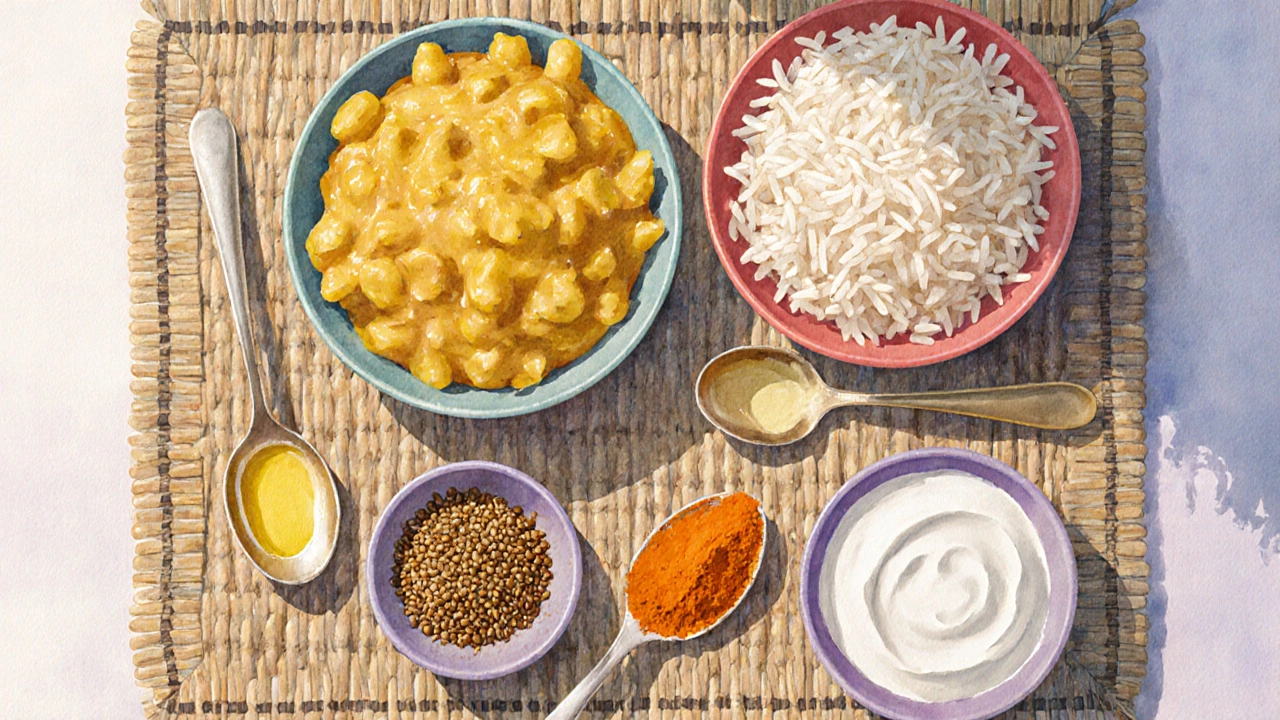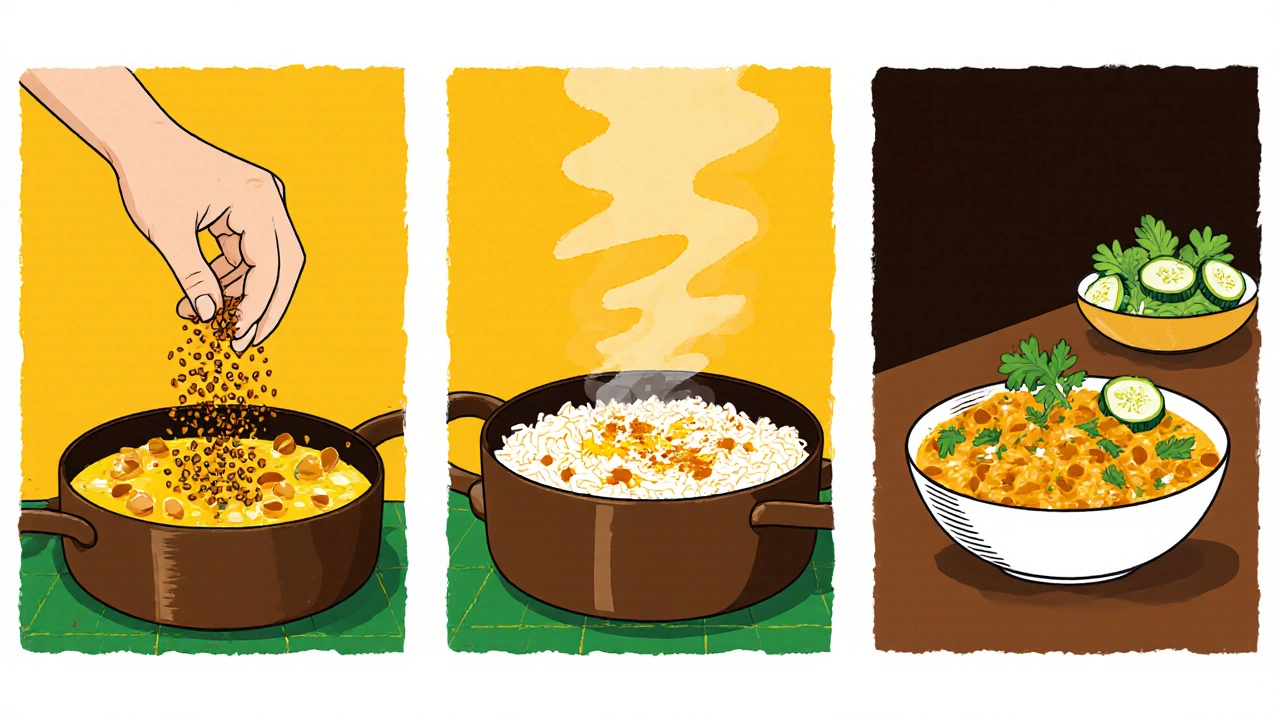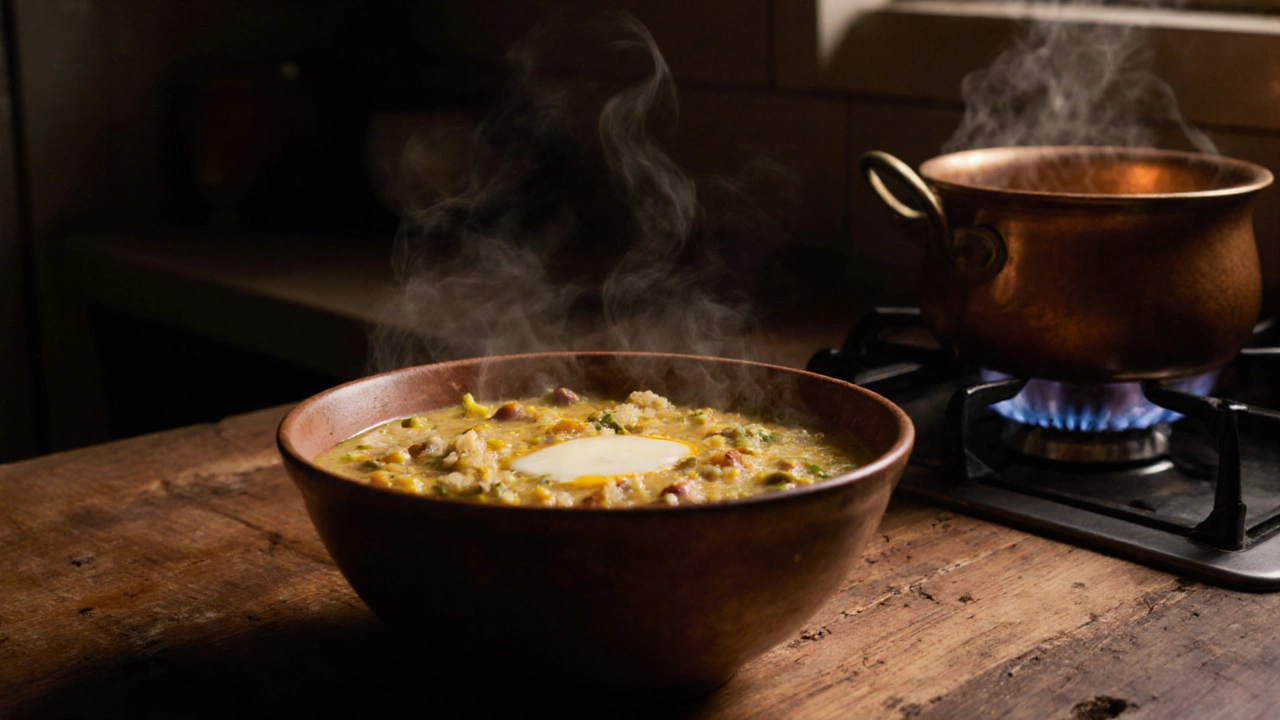Mild Indian Dish Quantity Adjuster
Adjust Moong Dal Khichdi Recipe
Adjusted Recipe:
Looking for an Indian dish that won’t set your mouth on fire? You’re not alone-many people love the comforting flavors of Indian cuisine but shy away because they assume it’s always blazing hot. The good news is that Indian cooking offers plenty of gentle options that keep the aroma and richness without the heat. Below we’ll explore what makes a dish mild, highlight a handful of go‑to recipes, and walk you through a step‑by‑step guide for a classic mild Indian dish that’s perfect for anyone sensitive to spice.
What Defines a “Mild” Indian Dish?
In Indian cooking, “mild” usually means three things:
- Low pepper heat - the dish uses little to no chilies or black pepper.
- Balanced flavors - spices are used for aroma and depth, not for burning sensation.
- Gentle cooking technique - ingredients are often simmered or steamed, preserving softness.
Because spices like cumin, coriander, and turmeric add flavor without heat, they’re staples in mild preparations. The key is to avoid the heat‑generating agents (fresh green chilies, red chili powder, cayenne) or to keep them in tiny amounts.
Core Ingredients That Keep Heat at Bay
When you want a dish that’s easy on the palate, reach for these ingredients first. Each is introduced with a short micro‑data definition so search engines can recognize them.
Moong Dal is a split yellow lentil that cooks quickly and has a naturally creamy texture. It’s low in fat, high in protein, and takes on the flavor of any spice it meets. Basmati Rice is a long‑grain aromatic rice prized for its fluffy, non‑sticky grains. Pairing moong dal with basmati creates the comforting base for many mild dishes. Ghee is clarified butter that adds richness without the water content of regular butter. A little ghee to‑ast the spices releases their aroma without burning. Cumin Seeds provide an earthy, warm flavor that’s completely heat‑free. Turmeric lends a golden hue and mild bitterness, plus it’s a celebrated anti‑inflammatory spice. Finally, Ginger adds a fresh zing that awakens the palate without any burn. A splash of Yogurt (or dahi) at the end mellows the dish further and offers a cooling effect.
Top Mild Indian Dishes You Can Try
Below is a quick‑reference table that lists four popular low‑spice dishes, their main ingredients, prep time, and why they stay gentle on the tongue.
| Dish | Main Ingredients | Prep / Cook Time | Spice Level | Typical Calories (per serving) |
|---|---|---|---|---|
| Moong Dal Khichdi | Moong dal, basmati rice, ghee, cumin, turmeric, ginger | 30min | Mild | 210kcal |
| Vegetable Upma | Semolina, mixed veg, mustard seeds, curry leaves | 25min | Mild | 180kcal |
| Curd Rice (Thayir Saadam) | Cooked rice, yogurt, mustard seeds, curry leaves | 15min | Mild | 150kcal |
| Aloo Matar (Mild) | Potatoes, green peas, turmeric, garam masala (light) | 35min | Mild | 230kcal |

Step‑by‑Step Recipe: Moong Dal Khichdi
This one‑pot wonder is the ultimate comfort food for anyone who wants Indian flavor without the heat. It’s also a great starter for beginners because the technique is straightforward.
- Gather your ingredients:
- ½ cup Moong Dal
- ½ cup Basmati Rice
- 1tbsp Ghee
- ½ tsp Cumin Seeds
- ¼ tsp Turmeric
- 1 tsp finely grated Ginger
- 4 cups water (or low‑salt vegetable broth)
- Salt to taste
- Optional: 2 tbsp plain Yogurt for serving
- Rinse and soak: Give the dal and rice a quick rinse under running water. Soak them together for 10‑15 minutes; this speeds up cooking and gives a fluffier texture.
- Toast the spices: Heat ghee in a heavy‑bottomed pot over medium heat. Add cumin seeds and let them crackle-about 10 seconds. Stir in ginger and sauté for another 20 seconds; you’ll smell the aroma but not see any color change.
- Combine dry ingredients: Drain the soaked dal‑rice mixture and add it to the pot. Sprinkle turmeric and salt, then pour in the water or broth.
- Cook: Bring to a gentle boil, then reduce heat to low, cover, and let it simmer for 20‑25 minutes. Check after 15 minutes; if there’s too much liquid, uncover and let it evaporate.
- Finish: Once the grains are soft and the mixture looks creamy, turn off the heat. Let it sit, covered, for 5 minutes. Fluff lightly with a fork.
- If you love a touch of coolness, stir in a spoonful of yogurt right before serving.
- Serve: Spoon the khichdi into a bowl, drizzle a tiny bit more ghee on top, and enjoy with a side of pickles or a simple cucumber salad if you’d like a contrast.
Nutrition snapshot: Approximately 210kcal per cup, 8g protein, 3g fat, and a good dose of fiber from the lentils.
Tips to Keep Your Dish Mild Yet Flavorful
- Control chili exposure. If a recipe calls for a pinch of red chili powder, replace it with paprika for color or skip it entirely.
- Use whole spices. Whole cumin, mustard seeds, and bay leaves release aroma without adding heat.
- Balance with dairy. A dollop of yogurt, a splash of milk, or a swirl of cream instantly tones down any accidental spiciness.
- Fresh herbs over dried. Cilantro, mint, or curry leaves add brightness without heat.
- Mind the cooking oil. Over‑heating oil can create a bitter flavor that feels harsher than spice.
Pairings and Serving Ideas
Even a mild dish can shine when paired right. Here are a few simple combos:
- Raita or plain yogurt. The creamy coolness is a classic match for khichdi.
- Simple salad. Thinly sliced cucumber, carrot, and a squeeze of lemon add crunch.
- Flatbread. A soft roti or naan (choose the butter‑less version) rounds out the meal.
- Seasonal fruit. A slice of mango or a few grapes can finish the plate on a sweet note.

Common Mistakes and How to Fix Them
- Too dry or too watery. If it looks dry, add a splash of warm water and cover for a few minutes. If watery, uncover and simmer on low until excess evaporates.
- Over‑spicing. Taste as you go. Start with half the suggested amount of any spice; you can always add more later.
- Lentils not soft. Ensure you’ve soaked them; if still hard, add a few more minutes of simmering.
- Bland taste. A pinch of salt, a few drops of lemon juice, or a dash of ghee at the end can lift the flavor.
Quick FAQ
Frequently Asked Questions
Can I make khichdi in a pressure cooker?
Yes. Use 1 whistle on medium heat, then let the pressure release naturally. This cuts cooking time to about 10 minutes.
What if I’m vegan?
Swap ghee for a neutral oil like sunflower or coconut oil. The dish stays flavorful and fully plant‑based.
Can I add vegetables?
Absolutely. Diced carrots, peas, or spinach blend in nicely. Add them after the dal‑rice mixture has cooked for 10 minutes.
How long does leftover khichdi stay good?
Store in an airtight container in the fridge for up to 3 days. Reheat with a splash of water to restore the creamy texture.
Is khichdi suitable for babies?
Yes, as long as it’s blended or mashed and free of added salt. It provides protein, carbs, and gentle spices perfect for tiny tummies.
Next Steps
If you’ve never cooked Indian food before, start with the Moong Dal Khichdi recipe. Once you’re comfortable, experiment with other mild dishes from the comparison table-like Upma or Curd Rice. Remember, the secret to low‑spice Indian cooking is picking the right spices, watching the heat, and using dairy or yogurt to mellow any surprise kick.
Enjoy the soothing flavors, share the bowl with family, and feel confident that Indian cuisine can be as gentle as you need it to be.
